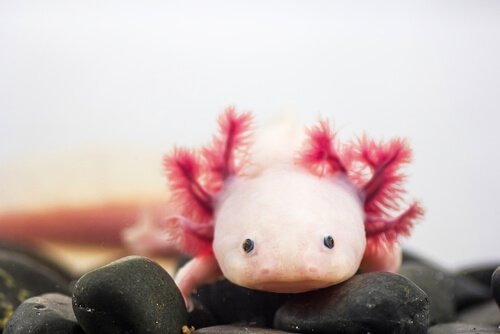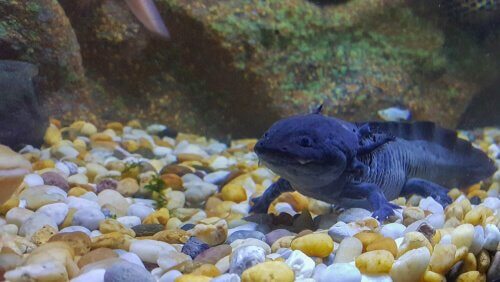What is the Axolotl?

The axolotl can be many different colors including black, gray, gold, albino, and white. They’re relatively easy to take care of, but they live their whole lives in the water. For that reason you have to make sure their tank is set to the right temperature.
Axolotls are endemic to Lake Xochimilco in Mexico. These animals are endangered because there are very few channels that lead to this lake. Fortunately, this depleted species can reproduce fairly easily in captivity. They are a fascinating subject for research because of their unique ability to regenerate entire members of their bodies.
Behavior of the axolotl
The axolotl is a relatively resistant animal. They’re tame in nature, but they should only be kept as exhibition pets, since they cannot interact with their owners outside of the tank. That’s because they’re delicate amphibians with a soft body and permeable skin.
Because of that, humans shouldn’t handle them unless completely necessary. They’re not especially social animals and they don’t benefit from having a companion.
Tanks
Axolotls can grow to be much larger than salamanders, so you’ll need at least one fish tank (aquarium) that can hold 18-23 gallons of water. However, the tank doesn’t have to be completely full; it just needs to be deeper than the animal’s total body length.

The tank should be in a cool room, away from direct sunlight. The water should be between 57 and 68 degrees Fahrenheit. Unlike with reptiles, you won’t need to purchase any special lighting for the axolotl.
In fact, what he’ll really need is a place where he can escape from the light. For example, you can put an upside-down pot in his aquarium, or one of those little castles they sell at pet shops.
If you want to add gravel to the bottom of the tank, you should use coarse gravel. The axolotl may accidentally ingest fine gravel if it’s in the tank, which would cause an obstruction.
Some owners simply choose to not put anything at the bottom of the tank. However, others think that this may stress out the axolotls, since they won’t be able to get a foothold on the bottom of the tank without the gravel.
Use an appropriate filter
Most homeowners will find a filtered aquarium easier to care for than an unfiltered one. That’s because unfiltered water has to be changed more frequently. However, if you choose to put a filter in your tank, you should choose a slow filter. You should avoid filters that can create strong currents.
If you have a filter, you should use a siphon to safely clean the bottom of the tank; you should also change 20% of the water on a weekly basis. On the other hand, if you’re not using a filter, you’ll have to change 20% of the water every day or every other day.
Remember, you should never completely change the water. That’s because this will drastically change the chemistry of the water that your axolotl is living in.

If you’re using tap water, make sure the chlorine or chloramines have been removed during the water treatment process. You can do this using commercially available solutions. Never use distilled water and make sure the pH of the water stays between 6.5 and 7.5 (neutral).
Food and water
In nature, axolotls feed on snails, worms, crustaceans, small fish and small amphibians. In captivity, they can eat a variety of brine shrimp, small strips of beef or liver, earthworms and other frozen foods made for fish. Each day, you should make sure you remove any food from his tank that he hasn’t eaten.
Common health problems
In some cases, the axolotl can undergo metamorphosis. However, this can be stressful for the animal and isn’t very common. Experts aren’t entirely sure under what conditions this can take place.
One thing we know is that metamorphosis can be induced by changes in water characteristics or by giving the axolotl certain thyroid hormones.
Of course, the terrestrial axolotl after the metamorphosis requires entirely different care. In addition, you shouldn’t try to induce metamorphosis, since this can exert a lot of pressure on the animal, which will greatly reduce his lifespan.
Axolotls often eat gravel or part of their substrate. They’re also often prone to gastrointestinal obstruction as a result of consuming foreign objects. Intestinal obstructions are a common cause of death in these amphibians.
Therefore, you have to make sure you buy the right size gravel, and keep any small objects out of its tank.
All cited sources were thoroughly reviewed by our team to ensure their quality, reliability, currency, and validity. The bibliography of this article was considered reliable and of academic or scientific accuracy.
- González, H. M., & Zamora, E. (2014). Manual básico para el cuidado en cautiverio del axolote de Xochimilco (Ambystoma mexicanum). Laboratorio de Restauración ecológica, Instituto de Biologia UNAM.
- FLORES, A. Programas de conservación de Ambystoma mexicanum (Caudata: Ambystomatidae) en el Lago de Xochimilco.
- ZAMORA, E. S. (2011). MÉDICA VETERINARIA ZOOTECNISTA (Doctoral dissertation, UNIVERSIDAD NACIONAL AUTÓNOMA DE MÉXICO).
- Akerberg, V. D. Á., Martínez, T. M. G., Hernández, A. G., & Trejo, M. V. (2021). El género Ambystoma en México¿ Qué son los ajolotes?. CIENCIA ergo-sum, Revista Científica Multidisciplinaria de Prospectiva, 28(2).
This text is provided for informational purposes only and does not replace consultation with a professional. If in doubt, consult your specialist.